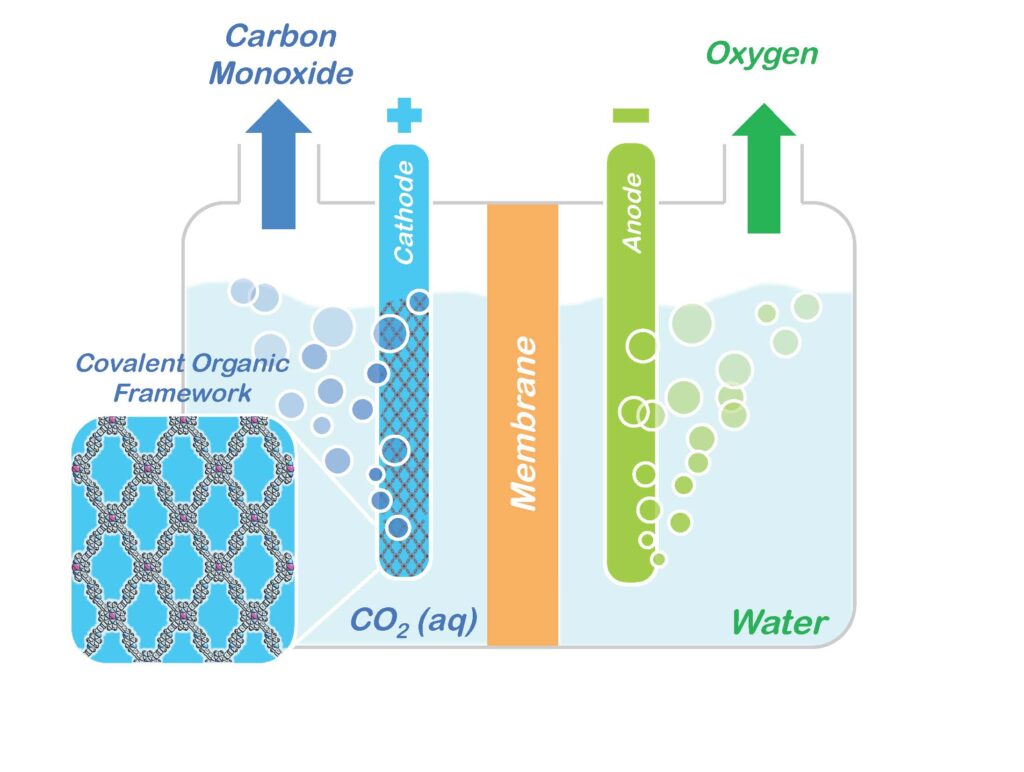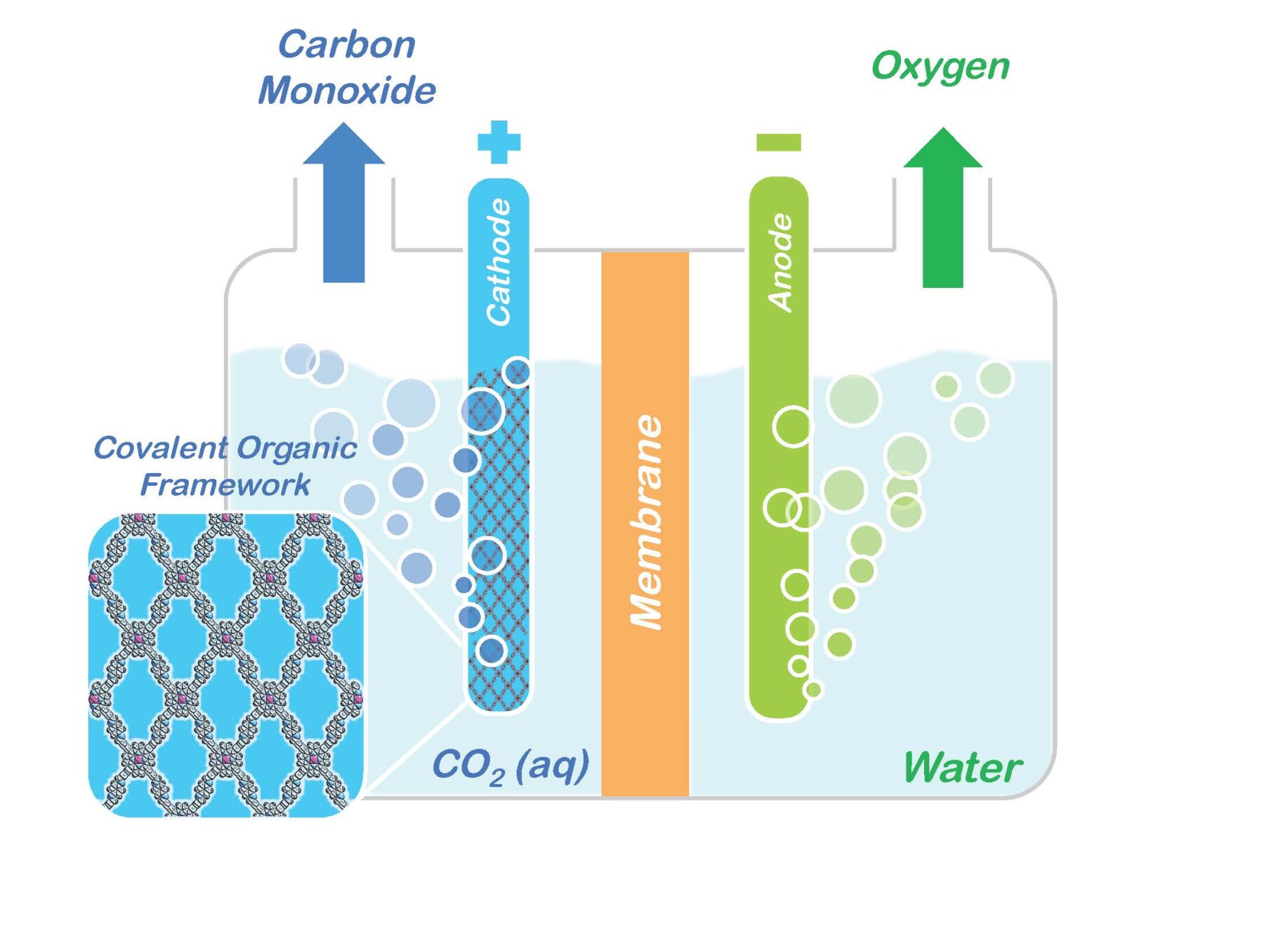
A molecular system that holds great promise for the capture and storage of carbon dioxide has been modified so that it now also holds great promise as a catalyst for converting captured carbon dioxide into valuable chemical products.
The sponge-like quality of a COF’s vast internal surface area enables the system to absorb and store enormous quantities of targeted molecules, such as carbon dioxide.
Researchers with the U.S. Department of Energy (DOE)’s Lawrence Berkeley National Laboratory (Berkeley Lab) have incorporated molecules of carbon dioxide reduction catalysts into the sponge-like crystals of covalent organic frameworks (COFs). This creates a molecular system that not only absorbs carbon dioxide, but also selectively reduces it to carbon monoxide, which serves as a primary building block for a wide range of chemical products including fuels, pharmaceuticals and plastics.
“There have been many attempts to develop homogeneous or heterogeneous catalysts for carbon dioxide, but the beauty of using COFs is that we can mix-and-match the best of both worlds, meaning we have molecular control by choice of catalysts plus the robust crystalline nature of the COF,” says Christopher Chang, a chemist with Berkeley Lab’s Chemical Sciences Division, and a co-leader of this study. “To date, such porous materials have mainly been used for carbon capture and separation, but in showing they can also be used for carbon dioxide catalysis, our results open up a huge range of potential applications in catalysis and energy.”
Chang and Omar Yaghi, a chemist with Berkeley Lab’s Materials Sciences Division who invented COFs, are the corresponding authors of a paper in Science that describes this research in detail. The paper is titled “Covalent organic frameworks comprising cobalt porphyrins for catalytic CO2 reduction in water.” Lead authors are Song Lin, Christian Diercks and Yue-Biao Zhang. Other co-authors are Nikolay Kornienko, Eva Nichols, Yingbo Zhao, Aubrey Paris, Dohyung Kim and Peidong Yang.
Chang and Yaghi both hold appointments with the University of California (UC) Berkeley. Chang is also a Howard Hughes Medical Institute (HHMI) investigator. Yaghi is co-director of the Kavli Energy NanoScience Institute (Kavli-ENSI) at UC Berkeley.
The notoriety of carbon dioxide for its impact on the atmosphere and global climate change has overshadowed its value as an abundant, renewable, nontoxic and nonflammable source of carbon for the manufacturing of widely used chemical products. With the reduction of atmospheric carbon dioxide emissions in mind, Yaghi and his research group at the University of Michigan in 2005 designed and developed the first COFs as a means of separating carbon dioxide from flue gases. A COF is a porous three-dimensional crystal consisting of a tightly folded, compact framework that features an extraordinarily large internal surface area – a COF the size of a sugar cube were it to be opened and unfolded would blanket a football field.
The sponge-like quality of a COF’s vast internal surface area enables the system to absorb and store enormous quantities of targeted molecules, such as carbon dioxide.
Read more: Soaking Up Carbon Dioxide and Turning it into Valuable Products
The Latest on: Covalent organic frameworks
[google_news title=”” keyword=”covalent organic frameworks” num_posts=”10″ blurb_length=”0″ show_thumb=”left”]
via Google News
The Latest on: Covalent organic frameworks
- Next-Generation Materials for Water Purificationon April 29, 2024 at 9:03 am
Water is an increasingly scarce resource, with natural reserves depleting rapidly. The United Nations Environment Program (UNEP) has identified around 2.4 billion people as living in areas identified ...
- When does a conductor not conduct? Switching a 2D metal-organic framework from an insulator to a metalon April 29, 2024 at 7:40 am
An Australian-led study has found unusual insulating behavior in a new atomically-thin material—and the ability to switch it on and off.
- Switching a 2D metal-organic framework from an insulator to a metalon April 28, 2024 at 5:00 pm
The atomically thin (or ‘2D’) material at the heart of the study is a type of MOF, a class of materials composed from organic molecules and metal atoms. “Thanks to the versatility of supramolecular ...
- When nano- meets climate technologyon April 22, 2024 at 4:59 pm
Other classes of reticular materials, such as covalent organic frameworks and hydrogen-bonded organic frameworks, hold similar potential to attain high hydrogen storage density at low pressure. An ...
via Bing News











